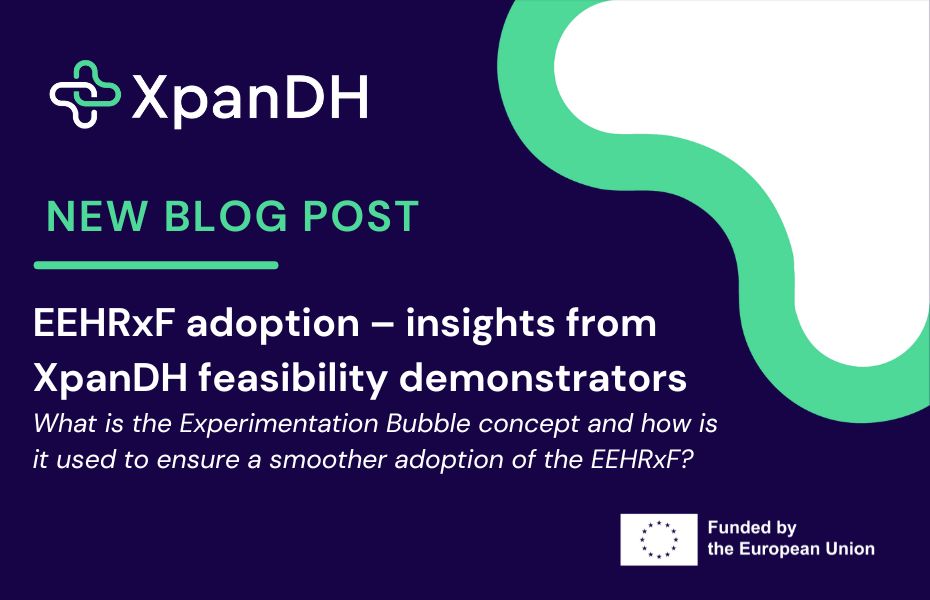XpanDH aims at mobilizing and building capacity in individuals and organizations to create, adapt and explore purposeful use of interoperable digital health solutions based on a shared adoption of the EEHRxF across Europe. To achieve this objective, the project established the concept of Experimentation Bubble – a dynamic collaborative entity, interested in working around the EEHRxF, testing its feasibility, and paving the way for an easier and more sustainable adoption. XpanDH bubbles aim at representing a sample of the EU landscape, in what regards the needs of EEHRxF, based on their organizational and technical settings and aims.
Taking as starting point the existing European Commission (EC) priority categories at the start of the project*, an internal analysis was conducted to understand the main interests of partners and set their focus (Figure 1 – most interesting: dark blue, less interesting: light blue):
Having this in mind, and considering the heterogeneity and levels of maturity among them, the bubbles were divided into three main groups (Figure 2):
i) X-Bubbles 1-6: constituted by groups of organizations, partners of XpanDH consortium, who deeply dived into the existing eHealthNetwrok guidelines and analysed how applicable were them for their particular case; ii) “In silico” bubbles: constituted by groups of organisations, either associated partners to XpanDH or collaborate with the project in a more informal way, who followed the work being conducted, presented and discussed their strategies for adoption; iii) xShare Adoption Sites: similar to the “In silico” bubbles they arise from the collaboration and synergy with the xShare project. Also, to enlarge the discussion and get a better sense of what is in fact the level of work being conducted, different strategies were applied, including 1o1 meetings, dedicated workshops and online surveys**. In total, more that 40 organisations were consulted and engaged (Figure 3):
The results allowed to better inform the specification work for each category, in particular for the cases of Laboratory results and Hospital Discharge reports, as well as to identify needs for achieveing seamless interoperability. The most prement one is the need for the national agencies to continue the efforts of mapping national coding systems to international codes, such as LOINC and SNOMED CT. Also, and as the lists of this coding systems are extensive, agreements on the value sets to be used are necessary. In addition, and for the specific case of Patient Summary, it is necessary to decide how frequently it should be updated, which information should be included, i.e. all information vs a subset (e.g. information from last 6 months), as well as who is responsible for its creation and maintenance. Finally, and in a more general perspective, the consideration of new extensions on categories were also recognised as of interest for e.g. better patient engagement in own health. This work continues to grow and we invite all organisations that have an interest on this matter to answer the online surveys (see footnote 3). A detailed analysis over the results obtained will be made available in a research paper to be published once the work is completed.
*In the EP resolution from 24th April 2024 (https://www.europarl.europa.eu/doceo/document/TA-9-2024-0331_EN.pdf) on the European Health Data Space (EHDS), these names are changed to: (a) patient summaries; (b) electronic prescriptions; (c) electronic dispensations; (d) medical imaging studies and related imaging reports; (e) medical test results, including laboratory and other diagnostic results and related reports; and (f) discharge reports.
** Survey on Laboratory results available at: https://ec.europa.eu/eusurvey/runner/XpanDHLabRep. Survey on Hospital Discharge reports available at: https://ec.europa.eu/eusurvey/runner/xPanDHDR. Survey on Patient Summary available at: https://ec.europa.eu/eusurvey/runner/xPanDHPS
About the author: Maria Marques, PhD in Electrical and Computers Engineering with more than 20 years of experience in research and innovation for building environments where technology is at a service of populations and a key enabler for digital health. Research interests include data management and connected infrastructure of wearables, (medical) smart devices, software applications, integrated in health systems as mean to provide better and more personalised services for the society as whole. Principal researcher at UNINOVA (www.uninova.pt). Member of the board for innovation and development at IDEA (www.idea-institute.pt). Independent expert close to the European Commission in the areas of Artificial Intelligence, Internet of Thigs (IoT), interoperability and decision support systems, among others. Leader of international and multidisciplinary teams in several R&I projects funded by the European Commission such as Smart4Health (deputy coordinator), XpanDH (leader of WP dedicated to feasibility demonstration) and xShare (co-leader of WP dedicated to patient-mediated health data exchange). Author of several scientific publications, many of them debating the usage of technology to ensure seamless integration in health environments.
